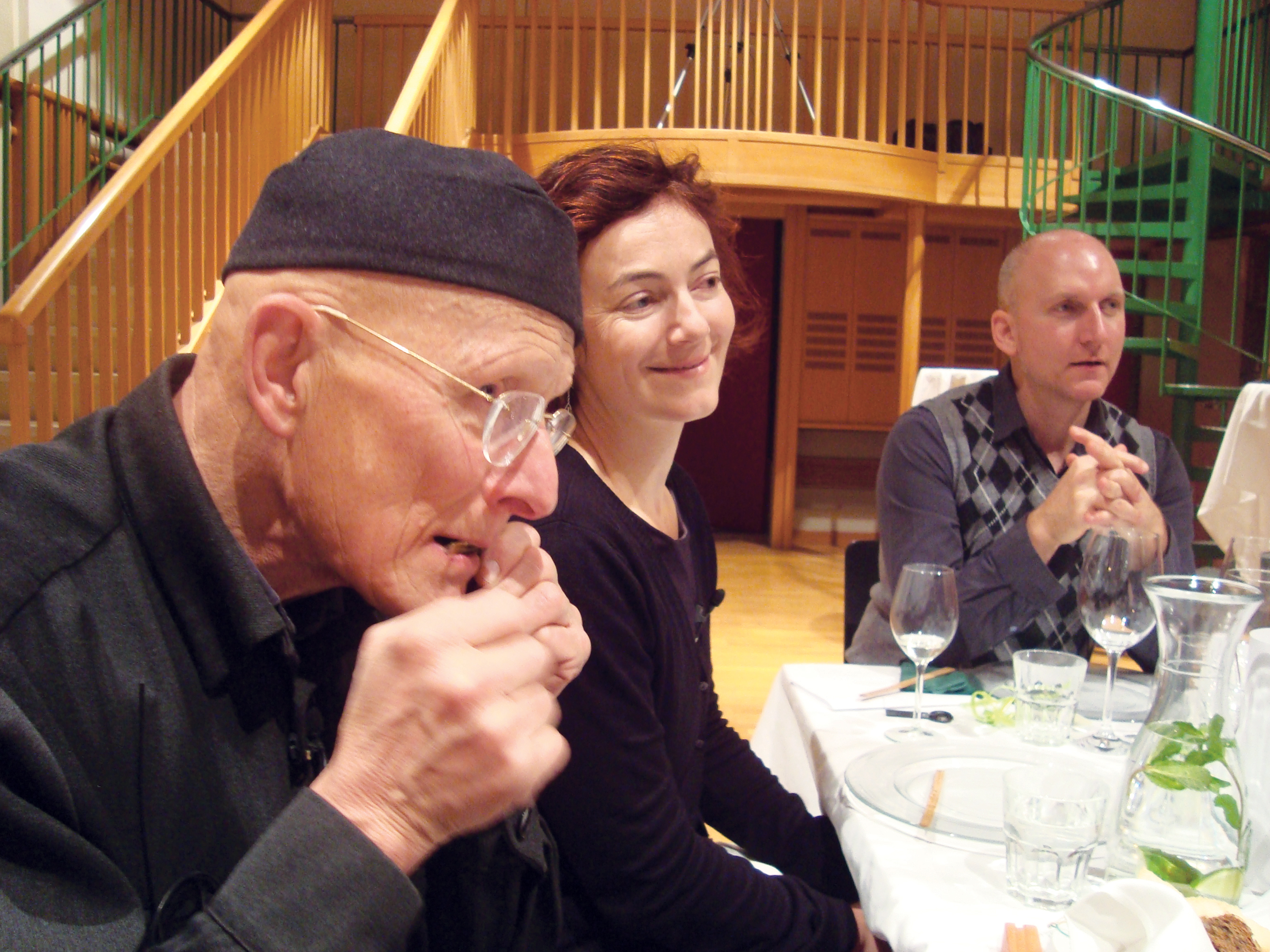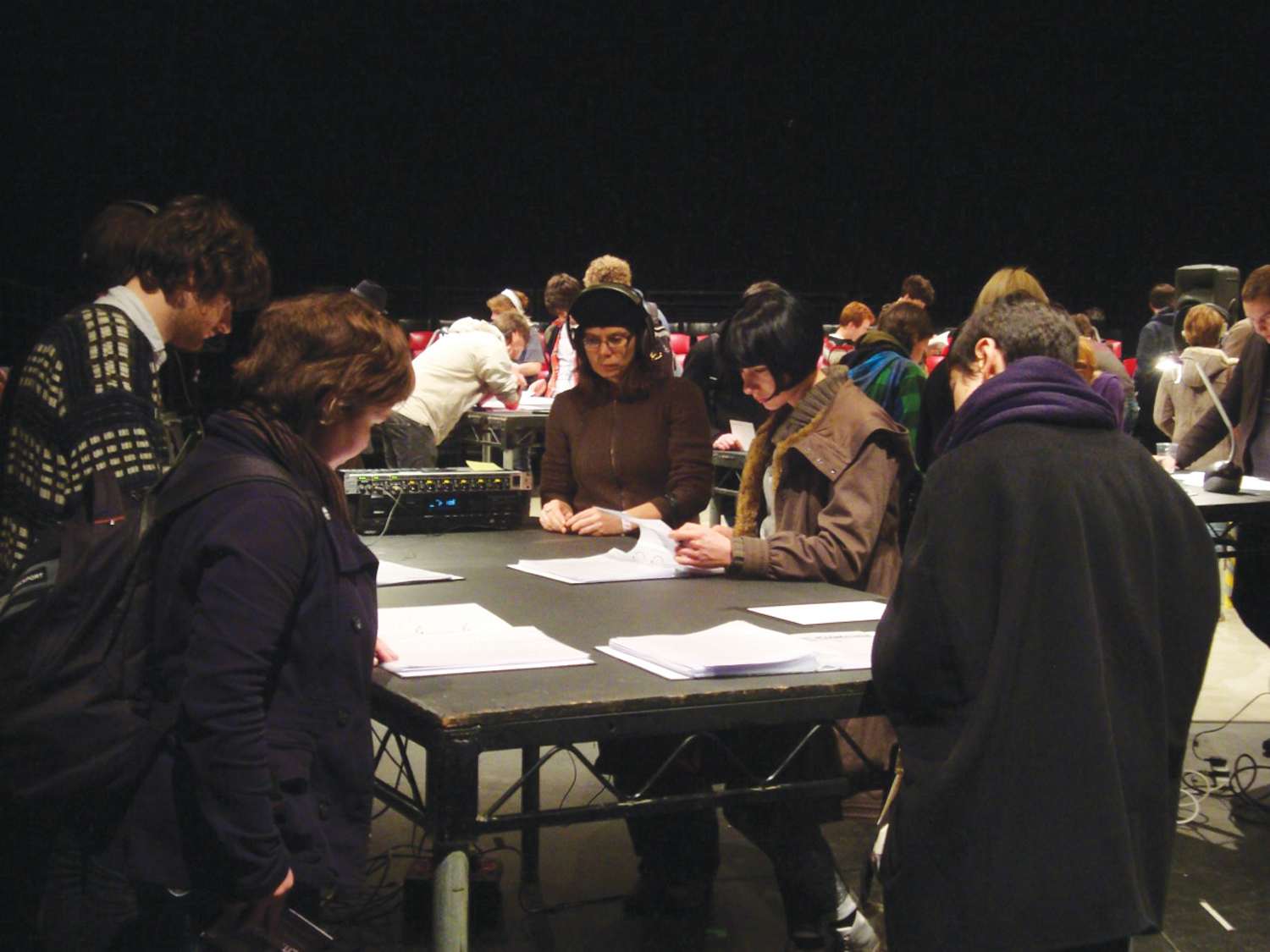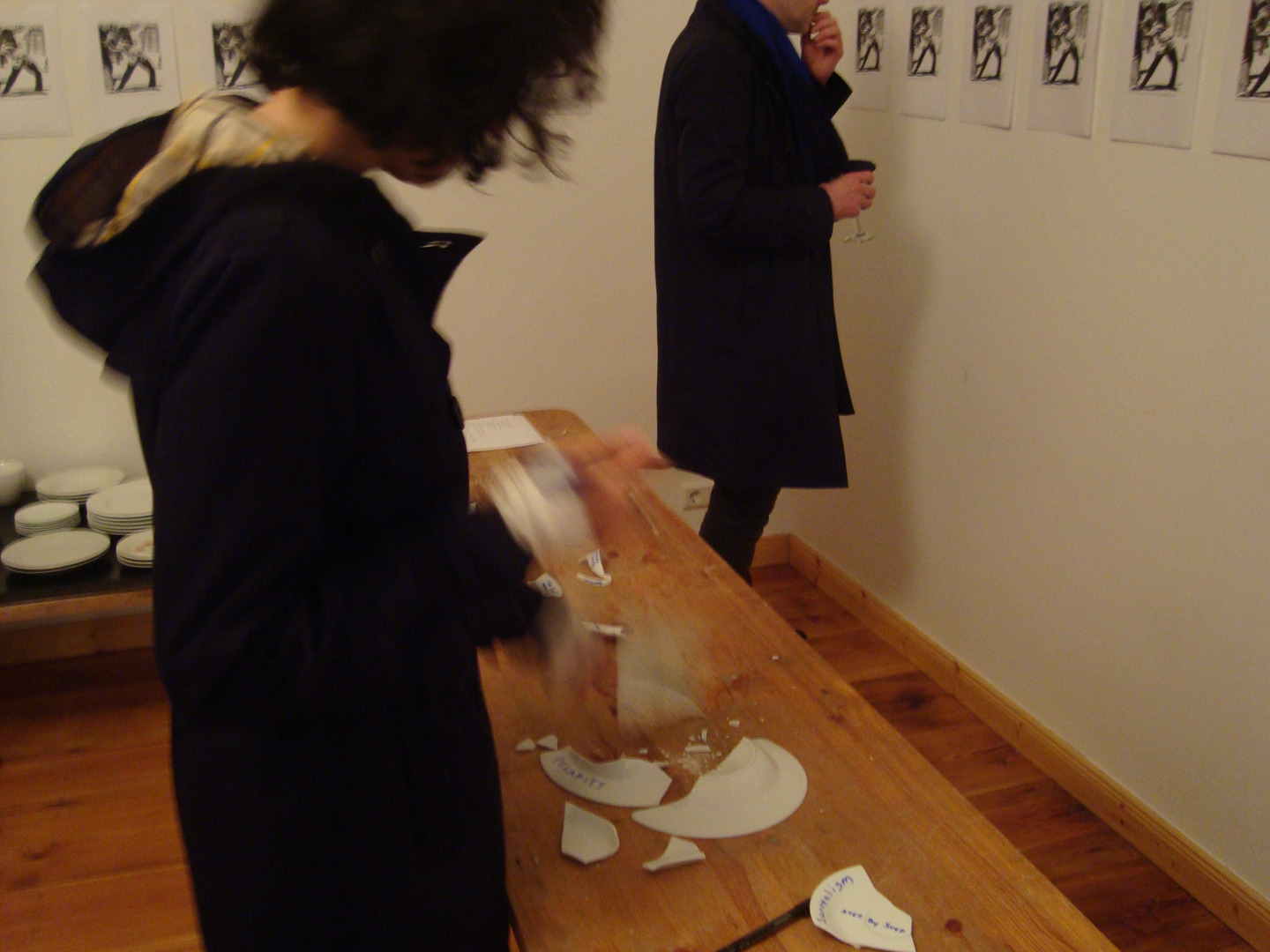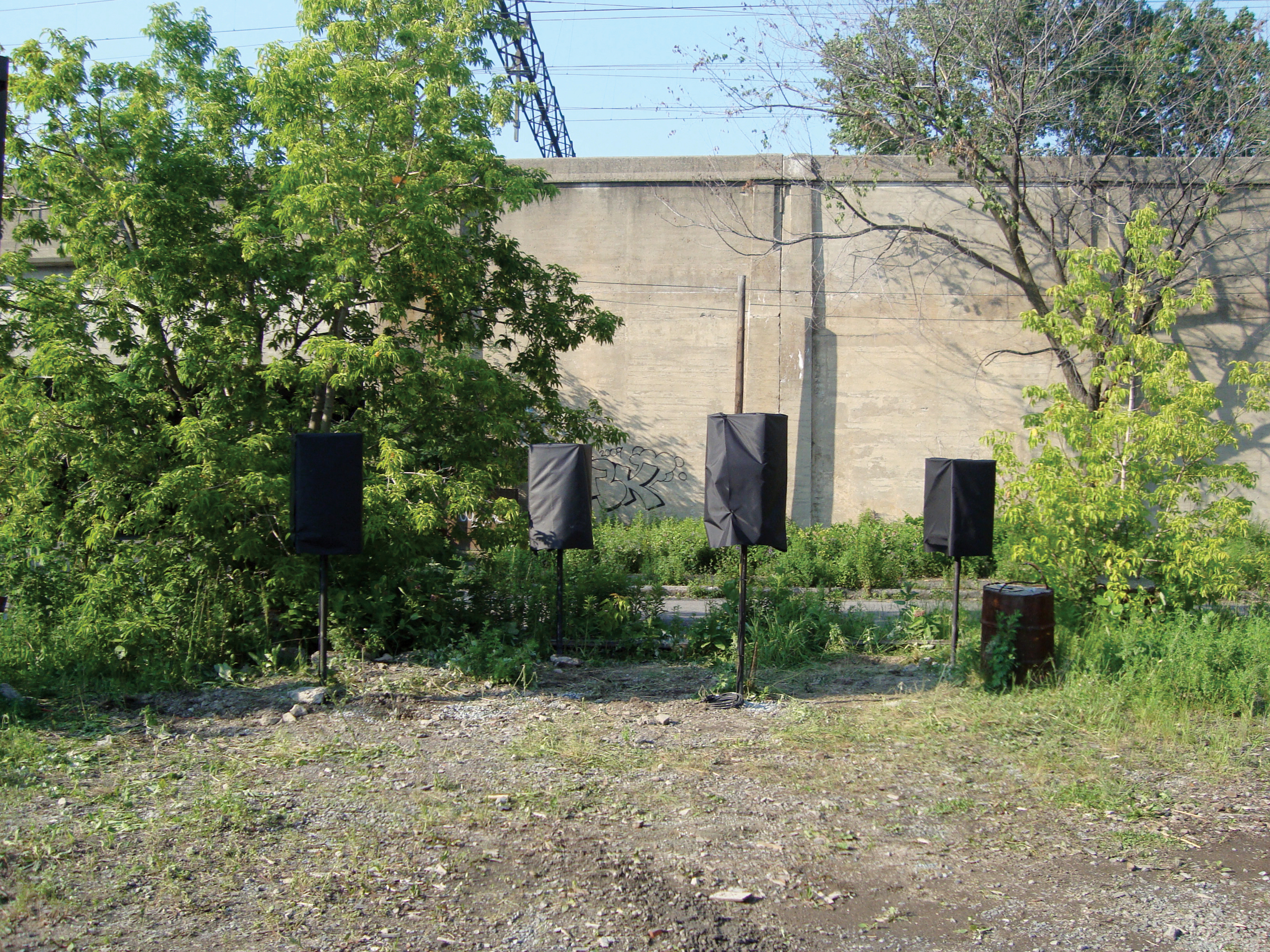« Features
The Acoustic Terrain of a Sound Artist: An Interview with Brandon LaBelle
Brandon LaBelle is an artist and writer living in Berlin. His work explores questions of social life and agency, using sound, performance, text and sited constructions. He also develops platforms for publishing and collaboration through Errant Bodies Press. His recent work has been presented at the Whitney Museum in New York (2012), Image Music Text Gallery in London (2011), MuseumsQuartier/Tonspur in Vienna (2009) and the 7th Bienal do Mercosul in Porto Alegre, Brazil (2009). He is the author of Diary of an Imaginary Egyptian (Errant Bodies, 2012), Acoustic Territories: Sound Culture and Everyday Life (Continuum, 2010), and Background Noise: Perspectives on Sound Art (Continuum, 2006). He is a professor at Bergen Academy of Art and Design, Norway.
By Stephen Knudsen
Stephen Knudsen - Why did you choose sound as the main resource in your work? How did you start experimenting with this medium?
Brandon LaBelle - Throughout the 1990s I was involved in both art and music, playing drums in different bands as well as developing sculptures and installation projects. There was definitely a moment where I started to expand my relationship to music into more experimental strategies, which eventually brought my work closer to sound, as a medium. I would say that my entrance into sound was fueled by this combination of art and music and their related cultural habits and communities. Sound for me suddenly opened up an extremely dynamic opportunity, a means for relating to places and people, while also suggesting an entire conceptual field. I think sound allows for more relational and situational work that can also address what it means to be a body, to be a subject, within language and the world.

Brandon LaBelle, Table Talk, Recording Phase in the sound studio, 2009, Brandon LaBelle is pictured in the far right. All images are courtesy of the artist.
S.K. - As you point out in your book Acoustic Territories: Sound Culture and Everyday Life, we are programmed in the womb by a voice dislocated from the face, that of our mother. In some of your pieces, such as The Accident, you brilliantly use a sort of naked voice dislocation. In this work, four speakers, each dedicated to a single voice, were placed for two months in the overgrowth and trash adjacent to an ugly Montreal parking lot. The four great social critique playwrights became the characters: Bertolt Brecht, Arthur Miller, Antonin Artaud, and Augusto Boal. They argue about what kind of play to stage, the ministrations of this public space, etc. The piece as you have stated was an “echo to current regeneration plans for Griffintown.” Of course, reordering of sight and sound is ubiquitous in modern life. But you do it in a way that is highly unusual. How did you come to realize that this kind of dislocation of voice from face was a sort of magic bullet to building enigma and intrigue?
B.L. - I’ve been working more with recorded voice over the last three years, and The Accident is part of this direction. This is generally based on exploring narrative and a sort of dramaturgy, where the work is installed as a ‘play’ of sorts, yet one that is recorded and amplified back into a specific location, and often within a larger set of sculptural and text elements. I like very much how the dislocated voice, as you say, can create presence to intervene while also remaining invisible, shadowy. I’m interested in bringing an audience into a narrative space and to use speech to also play with that space, to direct it. Like with the work in Montreal, the ‘characters’ speak about the city, about certain real aspects, while also performing against these as a counter-narrative: So the work poses the possibility of another story being told.
S.K. - This counter-narrative, it seems to me, is a critical aspect of the work. It keeps the piece enigmatic rather than propagandist. Besides the mystery of discovering a dialogue in just about the last place you would expect to find one, the listener is also turned about in the mystery of dialogue that is not singularly straightforward. The script for this ‘play’ is available on your website. Would you summarize and elaborate on this ‘counter-narrative’ (or ‘other story’) in the script?
B.L. - The dialogue or exchange between the characters moves across different topics, but generally they are discussing what to do in Montreal; we come to realize that they have been brought here to develop a work, a play. So each character adopts a different position on this, and in this regard I draw upon the characters as real figures, each with their own strategies and politics, each with their own dramaturgical methods. I play with the question of the city and what theater might have to offer, especially when it comes to urban planning. The work also poses a sort of critical question to itself: As an artist invited to Montreal to make a public work, and in response to the issue of gentrification, what might I do? So the dialogue itself performs this questioning, exposes it as a series of possibilities, of arguments. The proliferation of argumentation opens up the idea of the counter-narrative. You might say that I’m unfolding my own internal monologue in the form of four voices, four perspectives. Ultimately, they resolve this through the theme of ‘an accident’-the accident comes to serve as a strategy for not only inserting an artistic work in the city, but for bringing a public together. The accident is a combination of chaos and care, disorder or breakdown, and the energy that comes forward to restore and renew, to rebuild what has fallen.
S.K. - In your book Background Noise: Perspectives on Sound Art, you dedicate a lot of space to Vito Acconci’s 1972 Seed Bed, in which the artist is hidden under a ramp and, as museum goers walk the ramp, he speaks to them. In 2003 you made an homage exhibit, Learning from Seedbed. Was Acconci a major influence in your work? What exactly have you learned from him?
B.L. - I was always interested in Acconci’s work, as performance, as language and as space: His early works are extremely interesting for how they bring these elements into play; this of course continues in his later installation and architectural projects. I wouldn’t say he was a major influence, but definitely, I can always go back to his works and still learn from them, particularly around issues of ‘public space,’ or maybe ‘the body’ and its relation to being public, to being private and their intersection-how ‘community’ is actually much more complex, much more difficult than we might imagine.
S.K. - Getting back to the sociopolitical aspect of your work and a lot of sound art, I understand that this was a main focus in your PhD dissertation. Despite its immateriality, sound can create and modify an environment, conditioning architectural and physical spaces and influencing social and cultural behaviors. In your text Acoustic Territories: Sound Culture and Everyday Life, you explored these premises and how sound can participate in politics. Can you share with us some of the most interesting cases that led you to your conclusions?
B.L. - The work tries to map the urban environment through expressions and experiences of sound, as well as noise. One of the things I was keen to focus on was how sound may create boundaries and borders, and how it is used in design strategies, both formal and informal. One case in point is the example of Muzak. While this immediately connects us to ‘music,’ we can also see how Muzak developed out of a greater understanding and research on the psychoacoustic effects of listening over long periods of time. Muzak aims to condition the environment, particularly that of consumer spaces, by utilizing the effects of music and hearing. I trace out this phenomenon as one instant of ‘acoustic territoriality,’ while also examining sorts of counter-work: for instance, how different artistic projects try to also interrupt the more formal, managerial project of Muzak. Throughout the work I’m interested in addressing sound in this double-movement, to suggest that its place within everyday life affords types of control as well as resistance, and that often what we imagine as noise is more an expression of cultural encounter.

Brandon LaBelle, Temporary Outpost for an Auditory Figure, Exhibited at Instal 10, Tramway, Glasgow, November, 2010 This is a collection of sonic amplifications, video documents, texts and artifacts presented as an installation.
S.K. - The research project for your text, Acoustic Territories, continues in Temporary Outpost for an Auditory Figure, an installation that works as archival space that includes sonic amplifications, video documents and sound-based artifacts that you presented in Glasgow in 2010. Can you tell us more about this project? Is it an ongoing one?
B.L. - After completing Acoustic Territories I definitely had a feeling that the work could continue to have a life, as an ongoing platform for further research and also conversation. The Temporary Outpost project grew out of this feeling, and I take it as an opportunity to present Acoustic Territories though in an installation format: The project is a collection of materials I amassed in developing the book project. I present these materials as a type of archive-an archive without closure. These documents-mainly photocopied texts organized into different categories, such as ‘car culture’ or ‘prison architecture’-attempt to position sound, auditory culture and listening within an extremely expanded and associative structure of references, cultural narrative and modes of analysis. I’m extremely interested in sound as an itinerant figure, and this is something central to Acoustic Territories. I suggest that sound provides an opportunity for making connections socially, and also in terms of knowledge, and so the installation is an attempt to materialize this, to give it a form. In addition to the documents, I’ve been developing both audio and video works, which operate to unfold some of the themes, such as vibration culture, or silence, through different media and different modes of address. Overall, the project is one that I keep developing, and I see it as a three-dimensional mode of researching: embodied research.
S.K. - Many of your sound works involve live performance. For instance, your 2011 Porcelain Workshop confronted Berlin gallery goers with stacks of ceramic dishes, which could be written on and then broken. In addition, rocks were placed on shelves and identified with dates of revolution and social conversions. The controversial image of Edward Said throwing a stone at an Israeli watchtower in July 2000 is displayed 20 times, each with a new caption, locating Said in different places and times of protest. Beyond the more obvious connotations of thrown stones breaking windows, etc., what were the other essential sound elements of this performance-based exhibit and the key effect?
B.L. - In some ways, of course, I was not so concerned with sound in this project. In general, I’m interested in considering different strategies for art making, and aspects of interaction and participation are elements within my work, and in this case, I was trying to develop another method for triggering participation. As you suggest, the performance aspect is really central here, and I was aiming to prolong that moment of ‘wanting something more’-Said throwing the stone becomes a narrative image for sparking further reflection on how it is we seek to interrupt a given system. The question then becomes: What do we do once things are broken?
S.K. - Sometimes the initial performance and the final piece are dislocated from each other, like Table Talk. A dinner party was recorded live with eight guests who professionally work with voice. They talk about the voice and its meaning while eating. The work was presented as an installation in the Tonspur passage of the MuseumsQuartier, Vienna, with eight voices on eight loudspeakers. Can you speak to the importance of dislocation (or relocation) in this piece? And with the relocation you chose a passageway rather than a room. Was this to capitalize on the contrast of sit-down versus walk-through?
B.L. - The work is based on an interest in the voice, and specifically how it performs within the social setting of the meal. I’ve always been fascinated by the meal as a space of sharing and how the material structures of the table and chair (not to mention food) forms a social setting. In this case, the meal was attended by eight participants, each of whom work with the voice-a singer, a psychoanalyst, a sound artist, a voice coach, etc. The idea was to have a meal and to talk together about the voice, to share experiences and our own research on the topic, while of course eating and drinking. I also had this somewhat perverse interest to hear the voice, but to also hear the eating, the drinking-the mouth full of words and language, but also other material. The voice as both language and body, together: excess. Locating the final recording in the passageway through an eight-speaker system was a way to focus onto the voice, onto the mouth, removing the actual setting, the image and the real event, so you are left with only the voice, the sound. I thought of this as a way of accentuating this aspect, bringing the subject into focus, and surrounding passersby with the movements of the meal.
S.K. - One of your most intriguing pieces is Meditation on a Future Horizon, in which you examine various historical texts and statements calling for social transformation. What is the idea behind this project? What were the criteria you followed to select the statements? How does this piece impact the public?
B.L. - This was also a pivotal piece for me, because in many ways I tried to broaden my work and understanding of sound, which was always based on an expanded view, but here I started to include an array of materials. The installation is more an environment, with books, tables, videos, sounds, documents, etc. It was presented as a ‘working space,’ a sort of studio, and tried to question in what way the notion of ‘revolution’ is embedded within the practice of the artist, how art-at least a certain thread of art making-positions itself as critique, as a practice of critical knowledge production. I was interested in looking at how this desire for social transformation recurs throughout history, at specific moments and in specific contexts, from the Irish uprising to Caribbean revolts, and how this hovers within the artistic imagination, like a type of creative fuel, an imperative. In making the work, I tried to unfold this in multiple ways, and rather than come up with a single object or expression, I decided to put everything in, to show it as a working process, that I myself as an artist was also addressing and reflecting upon my own tendency toward social transformation, toward a desire for rupture, for interruption, or for something more.

Brandon LaBelle, Prototypes for the mobilization and broadcast of fugitive sound exhibited at the Enrico Fornello Gallery, Prato, Italy, September 2007
S.K. - In Prototypes for the Mobilization and Broadcast of Fugitive Sound, a series of mobile sound carts with prepared sound pieces were made for specific locations, and as you have stated, “were available for visitors to leave the gallery with them to offer tangible methods for imagined noise interventions.” Were these actually taken to the streets? Would you explain this piece in more detail for us?
B.L. - I’ve always been very interested in making work that relates to a given environment or place. This for many years took the shape of site-specific, architectural interventions, what I thought of as ’supplements’ to existing conditions. I would often work on-site, building structures and sonic materials that drew from that environment and that also tried to create ‘extra-perspectives,’ you might say, sorts of ‘parasites.’ I think with the Prototypes this was one of the first steps toward moving away from such direct work and understanding ’site’ as also something that could move, that could circulate and that could be more open for people. I think I started to understand places more in terms of people and less about buildings. So the Prototypes are parked in the gallery but are available to be moved, to be taken out. In this instance, the objects were also sometimes placed outside the gallery, in a front courtyard, sort of like vehicles, and as far as I recall, they were taken out now and again by visitors. I don’t think they did much with them, and in some ways, it is also OK if they never move: For me, this exists always as an important potential-it is a proposition to the visitor, and also to myself, that the works are ‘at the ready.’
S.K. - Humor is a big part of Prototypes. I had to chuckle when I read your description of the cart second from left in the color plate: “For country dances, parties, raves, ho-downs, rodeos or circuses, to complement, through break down and multiplication of percussive expressions, and other various punctuations, the movement of bodies, animals, monsters and clowns, and their ritualistic catharsis, rapture or laughter, and the audiences that gather therein.” Any further thoughts?
B.L. - Definitely, I’m very interested in humor as an element in the work, in working with humor, which is also about people. Humor in a way is always social, while also breaking the social. It is always slightly out of place. This also has a certain poetics-a surprising poetics, which for me can also be a type of material.

Brandon LaBelle, Porcelain Workshop, Performed at the temporary residence of Volt Gallery at Kunstwerke Berlin, April 26, 2011
S.K. - From June 13th to 15th you organized the symposium “Resonant Bodies: Landscapes of Acoustic Tension” at ICI Berlin. It was accompanied by an exhibition of works of artists who explore the intersections between sound, music, environment and language. Can you share with us some of the conclusions of this event?
B.L. - It would be difficult to maybe find conclusions, but certainly, the symposium collected together an interesting array of different materials and voices. Our aim generally was not to try and sum up a particular field, but to create intersections, particularly between music and sound. One aspect that I think did materialize was an overall sense for expanding how we understand the experience of sound, which was maybe also about expanding our notion of the voice. This I think is developing more generally in tandem with all the work being done on ‘effect’ as well as ‘materialism’-the desire to recognize how non-human and, seemingly, inanimate things have a real presence within the world-and also, how our own sense of ‘the body’ is fully implicated within this expanded view, that what we experience is part of a greater interweave of sense and agency, and that sound and listening can provide an extremely dynamic pathway toward a new understanding of being public.
Stephen Knudsen is an artist and a professor of painting at Savannah College of Art and Design. He is a contributing editor and art critic for ARTPULSE and a contributing writer for NY Arts Magazine, Hyperallergic, The SECAC Review Journal and theartstory.org. He is also the senior editor of the anthology The ART Of Critique, which will be published this year.




































Leave a Reply
You must be logged in to post a comment.